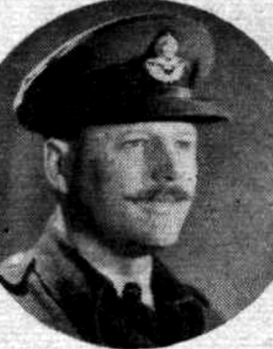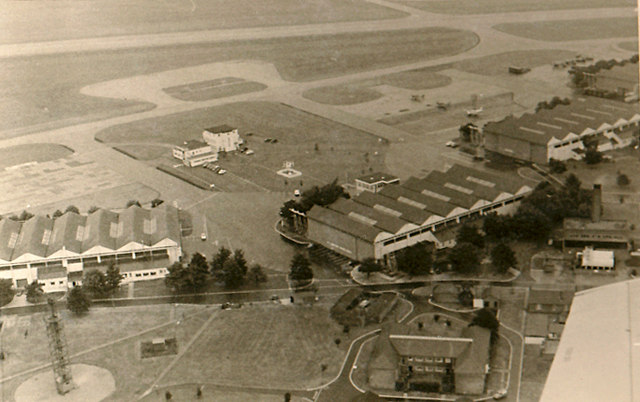
After the Palace Hotel, Torquay was Bombed in October 1942, Tom was Posted to RAF Abingdon No.10 OTU as an Instructor on No.1501 BAT Flight (Beam Approach Training Flight). Presumably, the Medics considered his Knee sound enough to endure the Rigours of Asymmetric Flight! No.10-OTU was formed in 1940 as part of No.8-Group RAF Bomber Command
Rusty: I am willing to bet that the vast majority of people reading this will never have heard of a Standard Beam Approach. I vaguely recall doing one in the Link Trainer at RAF Syerston, near the end of my Basic Training on the Piston Provost. Sure enough, on 3rd February 1960, my Log-book Records doing 45-mins on Exercise 7 (TBA) – which I assume stands for Terminal Beam Approach! This was my only flirtation with the intricacies of an SBA – thank God!
Keen readers may like to get hold of Air Publication 1732b: Instructor’s Handbook of Advanced Flying Training (Air Ministry May 1943)
In which Chapter 34 Spells it all out. Suffice it to say, that it is similar to an NDB (Non-Directional Beacon) Approach, with No Glide Path – but one helluva lot harder! Instead of a Needle to tell you when you are on the Centreline, you have to Interpret the Audible Dots & Dashes – Dots if you are to the Left, Dashes if you are to the Right & a Steady note if you are ever lucky enough to find that Centreline! You guys Flying modern ILS (Instrument Landing System) Approaches don’t know you’re born! The Instructors’ Handbook states simply: ‘The Aim is to enable the Pilot to return to Base & Land in Fog or extremely bad Visibility, or from a Low Cloud Base, by means of the Standard Beam-Approach System.’ The skill required to fly a dead accurate SBA & even more so to Instruct other Pilots in the Art, was recognised by the Powers-That-Be when choosing those Select Few who would Operate the best & most Exacting Bombing Device of WW2 – ‘Oboe‘.

When Tom joined No.1501 BAT Flight, the CO was Sqn Ldr North & his Deputy was Flt Lt Peter Kleboe. He was now back on Oxfords & Set to, Learning about the Standard Beam Approach. This must have been somewhat of a challenge, as he had been off Flying since 4th January 1942 – a Gap of about 10-months. He recalls: ‘I went there as an Instructor & after I really got into the Beam & was Coping, S/L North & Flt Lt Peter Kleboe were Posted & I took over the BAT Flight.
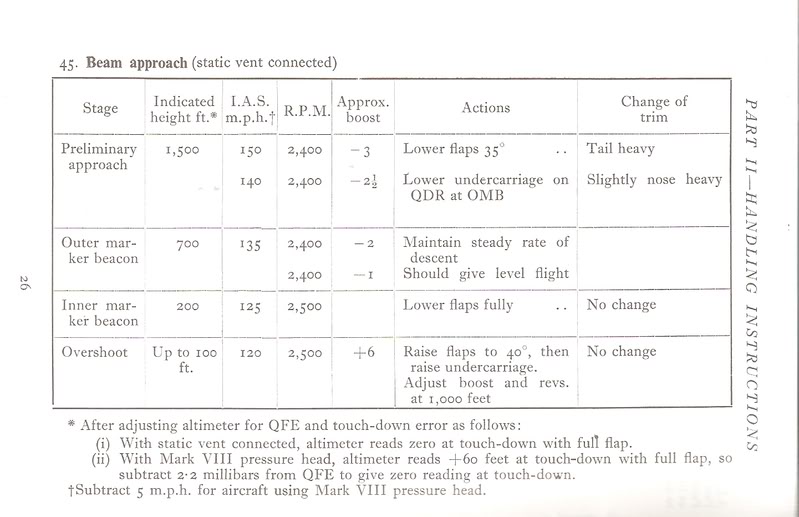
F/L Peter Kleboe went onto Mosquitoes & I think he Shot up Gestapo Headquarters in Copenhagen at Low-level. [Is there anything Nobler? Shades of that wonderful sequence in the Film, 633–Squadron, when the Norwegian Resistance Officer is being Tortured]. Unfortunately, he hit a Lamp Post & then a Roof & went Straight-in.
This was Operation Carthage, on 21st March 1945. Wing Commander Peter A Kleboe was Leading the 1st Wave, when his Mosquito Hit a 30M Lamp Post, then a Roof, damaging his Wing, causing him to Crash near the Jeanne d’Arc School. Both he & his Navigator, Fl Off Reginald J W Hall were Killed. Regrettably, the Smoke & Flames Led the 3rd Wave to mistake Kleboe’s Crashed Mosquito for the Target, resulting in the Deaths of 86-Children, with another 67-Injured.

Tom continues: ‘At 1501 BAT Flight, we were Training Instructors, from all around the Service. We’d start on a Monday morning, going all through it & explaining it in detail, getting them used to it. Then on Monday afternoon, Flying – we did all sorts of Exercises & it finished up the next Saturday morning, where we had to Fly-off & Cut an Engine on Take-off: very Stupid but we did! Because that was in the Curriculum! Then we would Land at another Aerodrome – very frequently it was RAF Harwell, which was later a Nuclear place. (The original Grass Field was replaced with Concrete Runways between July & November 1941) Then they would have to come back. We Spun the Gyro to Lose them & they’d have to find their way back to Abingdon! They did this by Tuning into Abingdon’s Frequency. [no, not Air Traffic Control for a QDM/Magnetic Heading to Steer for Base, but the Beacon’s Frequency!]. You know how the Beam goes to nothing – Cone of Silence – over the Main Beam?’

It was a most demanding Course, mostly consisting of Taking-off up to 100-ft or so, at which Point the Instructor pulled a Screen over the Trainee’s Side of the Cockpit blacking-out everything. From then on Flying was by Instruments Only, guided by the Radio Beam System until on the Final Stage of the Approach for Landing, when the Instructor then removed the Screen. The Beam Approach (sometimes known as Blind Approach) System relied on 2-Audible Signals, Morse A (dit dah) & N (dah dit) which originated from differing parts of the Airfield, which was “Divided” into 4-Quadrants. Listening to the Signals, the Pilot knew which side of the Airfield he was Flying in from. When he started hearing both Signals of different strengths, he was aware of how close to the Centreline he was. When both Signals Merged & became a Continuous Sound, he knew he was “on the Beam“. Ancillary Signals enabled the Pilot to Land in very poor conditions. This is a huge Simplification of what was, in fact, a Complicated set of Learned Instructions involving many changes of Direction & Height as well as swift Calculations of Orientation in response to the Audible Signals you were receiving.
The Beam Approach System was a relatively New Technology in 1942 & was still very much under Development. The idea was to Guide Tired & often Injured Crews to Land Safely in the Dark or in reduced Visibility such as Fog. The Beam Approach System would be installed only on the Main Runway with 2–Main Beacons (Inner & Outer) which Transmitted Signals to a Receiver Set in the Aircraft. A fixed narrow Radio Beam gave out a continuous Tone Signal when the Aircraft was correctly in Line with the Runway, to the Left of Approach Dots would be heard & to the Right dashes were heard, on either side when Flying Offline. The Pilot had to keep the Aircraft Flying along the Line of the Continuous Tone (Riding the Beam) until he reached the Airfield & was able to Land. Once within 10 or 15-miles of the Aerodrome, the Beam Approach System was turned on & the Guidance System would Begin.
‘Yes!‘, I replied, with Conviction!
Tom elaborated: ‘It goes out like this, about 2°-Wide, right across the Country. So you then Flew until you got to the Beam, Flew across it, turned around & Flew across it again & if on the 2nd-time you Crossed it, the Beam was narrower than the 1st-time, then the Aerodrome was this way. So they had to then find it, get on the Beam, Settle down, do a figure of 8 & all these things. If it wasn’t Cloudy or Foggy, they would have a Canvas Hood over them. I used to Pass them Out, if they reached the required Standard, every Saturday morning. I Flew every day myself, for about a year, because I liked it. We used to Take-off in the Thickest Fog: our Boast was that we were never Grounded, even in the thickest Pea-souper, as Thames Valley Fogs used to be then – we Flew every single day! We never Broke an Aeroplane, either, or Lost Anybody. But there was one ‘hairy occasion’ where it was so Near it wasn’t true.

This was 1-Morning, in a Pea-souper, with thick Frontal Cloud right on the Ground, when I had the Aircraft Wheeled out onto the End of the Runway & pointed in the Right Direction. I had 2-Flight Lieutenant Students and a Flight Sergeant Wireless Operator, named Whitehead. We were Flying around on the Beam quite happily, when all of a sudden, there was a Bang & a Thump, and the Aircraft nearly shook itself to pieces. I couldn’t think what happened! I looked around, and it was obviously in the Starboard Engine. There was stuff coming up from the Floor & odd pieces of Paper & Charts Flying around – it was a very Nasty thing! Then Smoke started coming in & I thought, Oh My God, what’s this then? Engine on Fire, or something? Well, we were only about 1,200-ft, & it didn’t Fly at all very well on 1-Engine, because of all the Radio Equipment we had & the 4 of us Onboard – & we were just losing height very, very slowly [see my earlier remarks on Single-Engined performance in an Oxford!]. I couldn’t do any better than let it come down very slowly to about 1,000 ft. I tried calling on the R/T, but you hadn’t got today’s sort of VHF then – you were lucky if you got through at all, unless you were nearly over the Aerodrome. We got back over Abingdon & I said, we’ve got a great problem – we’ve Lost an Engine – Aircraft is juddering itself to Pieces – can you give me a Diversion, probably South of here (because I knew the way that the Weather Front was going) – let me know what it is like at Harwell. Well, we couldn’t get a reply, just a lot of Static. So, we were coming down & had got to just below 1,000ft. I said, All right Chaps, there’s nothing else for it – we’ve got to Abandon the Aircraft! In an Oxford, it had a little Toggle on a Wire, by the Door. So I said, right, you 2 [Pilots] go, followed by Whitehead & Eject the Door – pull the Door, which will Jettison it, because we didn’t want anyone being caught in the Door on the way out. The 2-Pilots Jettisoned the Door & Baled out. By this time, I was down to about 800-ft. I said to Whitehead, at the top of my voice, or started to say your turn now! But when I turned round to say this to him, he was sitting next to me, saying, I’m sorry, Sir, I can’t go! I thought, Oh God, we were at 800-ft & I couldn’t see a thing! So I said to him, all right, sit on this Step. Now, this Step is where the Main Spar went through, and he Sat on it, with his arms around 2-Posts, in a sort of Crab position. Of course, I had no Hydraulics now. So I said, right when I say “Pump“, you Pump that Handle as hard as you can. When I say “now“, it means we’re going to Crash so you will have to get your Head down. So, with no Communications, the only thing that I could do was a Circuit, as though I was Landing & finish Up into the Wind – Pump the Wheels down, Pump some Flap Down & hope that I’d come out Crashing amongst some Treetops, with a Field in front of me. In which case, I’d be able to Land. If I couldn’t, well, that’s it! You never know – what else could you do? Nothing! [Pray? Think of England?] You could either just Sit there and say, Oh Well, that’s it! Or you could at least do this! So I did all this – I got the Wheels & Flaps down. Then I said to Whitehead, right now, keep your Arms round there & your Head down. I was going Down & Down, and I got Down to about 50 or 60-ft [good grief!] – I thought, any moment now, I ought to see some Bloody Trees! I looked out of the window & you wouldn’t believe it – there was a Banjo-standing [Aircraft Pan] right in front of me! They were usually round a Perimeter Track, where an Aircraft Taxied up to the Circle at the end & turned around. I thought, there must be an Aerodrome over there, in the Direction that the little Strip was pointing. Although I hadn’t got my Starboard Engine, and remembering all your instruction that you shouldn’t turn against the Dead Engine, I nonetheless put the Nose down the last few Feet – I did a Vertical turn to Starboard – and there was a great Runway in front of me! It was a Dead Fluke! I eased back, put all the Switches off, because I was worried about the Burning smells & did an Airfield Daisy-cutter up the Runway, at a place called RAF Oakley [between Oakley & Worminghall Villages! I’ll tell you what, when I saw that Aerodrome later on, it’s got Hills not very far away, on one side of it. [Good job the Huge TV Mast at nearby Beckley only materialised in the 1960s!] So I thought, well God, I was absolutely Lucky there! It was Sheer Luck, because I didn’t know where I was. Well, do you remember my telling you that only 4 of us out of 44 completed the Course on Hampden’s? Well, after I Landed, out came the CO of the Station – he was a Squadron Leader. It was on sort of Maintenance, not an Operational Station – I think it was probably a Training Station.
[Action Stations 6 Records that it was then an active Satellite of No.11-OTU, Westcott].
Of course, the place was closed [due to the Foul Weather]. This Chap started to say: “Can’t you see the Aerodrome is Closed?” Well, I hadn’t been Flying around the Signals Area outside the Watch Tower. So I said: “What the Hell?” he said: “What the Hell?” It was Royle [I trust this is the correct spelling!] – one of these Chaps on Hampden‘s. He had somehow Survived & had got this Job! So I gave Whitehead a few Quid & told him to go down to the Sergeants’ Mess, have a few Pints on me & stay there until I sent for him. I then got onto Abingdon & said that we’d had this Forced-landing & asked them what had happened to my 2-Flight Lieutenants. Oh, they said, these 2 had come down in a PoW Camp, near Oxford, where they had got a Practice Invasion Alert in Progress & all these Italians couldn’t understand why it had been so thorough as to have Parachutists coming Down! I think one of them had wrecked his Ankle. Anyway, they said – Leave the Aircraft there[!] – and they would send Transport out to us & pick up the 2–Flight Lieutenants on the way. I said, right, I’ll be in the Mess. Old Royle & I went to the Mess & of course, we had a ‘Right Old Session’. The Transport duly arrived & took us all back to Abingdon, where I made a Report of the Incident.
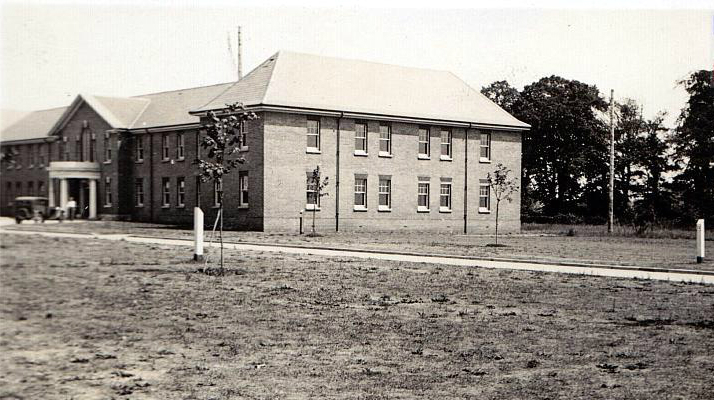
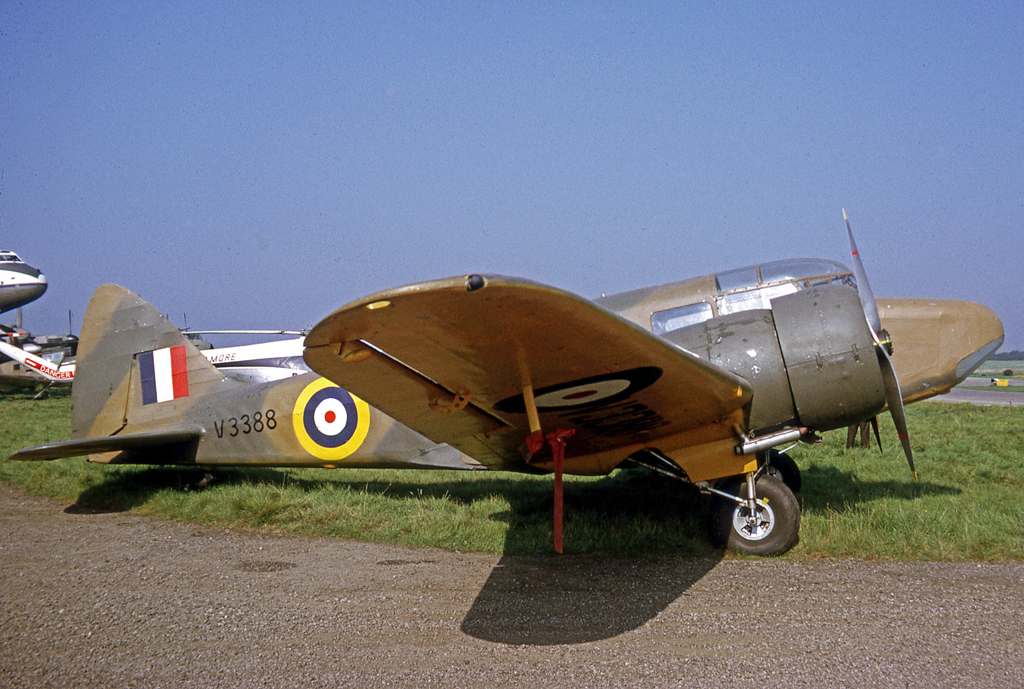
Now, this is what happened to our Engine. There’s a Bulkhead where the Engine Mounting is, to which is fixed around a Tubular Frame, by 4–Points like this – 4–Points under the Bulkhead. It’s got 4 little Tubes Fixed in this Round Frame, with the Engine fixed on the other side of this Round Frame by 4 little Tubes & Bolts and so on. So, of these 8 Points of Fixing, 7 of them had gone. Well, you could have pulled the Engine off with your Hand! It was leaning forward & it had broken various Wires, & Oil Pipes, which had Leaked onto the Hot Engine, which had caused the Smoke – it wasn’t on Fire. With the Engine hanging on by just 1-Point, it would have fallen off, had the Landing been harder!’
I think that Tom’s miraculous Arrival at RAF Oakley is one of the luckiest occurrences in the History of Aviation. Time & again, his run of Luck has convinced me that his Guardian Angel competently Steered him through all his Perilous Situations. I do not make this statement lightly – my own Guardian Angel was every bit as good, or I would not be typing this Biography! Anyone who still believes that this is fanciful thinking should read Lorna Byrne’s 3 excellent Books on Angels. They are the most outstanding & Influential Books I have ever read. You will not be disappointed.
I would like to return now to Tom’s Statement: ‘- and remembering all your instruction that you shouldn’t turn against the dead Engine -‘ I asked Tom to clarify this Statement. He replied: ‘Well, in the early days, you were always told Never Turn against the Dead Engine!’
This relic of WW2 has always fascinated me. Tom was an exceptional Pilot & no doubt related what the current Instructors were Pumping out. Between the end of the War & when I joined the RAF in 1959, it had quietly been swept under the Carpet. Or had it? Not very long ago, one of the Engineers involved in the Reconstruction of the World’s only Airworthy Blenheim actually quoted this to me, using the word ‘Never‘ – to my utter astonishment! So what was the basis for this Teaching?
Let’s return to the Instructors Handbook of Advanced Flying Training (May 1943) – Chapter 33. Single-Engine Flying (ME Types). Sub-paragraph (IVe) states:
‘Owing to the Offset Thrust Line it is easier to start a Turn with the Live Engine on the Outside, but such a turn is difficult to Stop & the Aircraft may get out of Control. For this reason, it is always safer & better to Turn Against the Live Engine [my italics]; such a turn will be harder to start but can easily be Stopped.’
Under the heading, Deliberately Turning on 1-Engine, sub-paragraph (xa) states:
‘Start a Turn with the Live Engine Outside – During the Turn show the tendencies for the Nose to Drop, the Bank to Increase & the Turn to tighten up. The recovery requires the Firm Application of Rudder & Ailerons which must be only slightly released when the Aircraft is Straight & Level; it may be necessary to Throttle Back the Live Engine somewhat during Recovery.’ In other words, emphasise the need for Extreme Caution when turning towards the Dead Engine, but Never say Never! I can imagine what modern-day Examiners would say if you refused to do a Single-Engined Hold or procedure Turn on an ILS Approach because you said you were not allowed to turn towards the Dead Engine! Of course, there may have been some Wartime Twins which were quite deadly when turning towards the Dead Engine – probably due to the inadequate Trimming available, leading to the Instruction to Never do this! Anybody who has Flown the Marks of Canberra up to PR7 will know the meaning of Inadequate Trimming! After practising Asymmetric on these Canberras your Legs would be shaking for at least 2-days afterwards – a phenomenon which we called ‘Canberra Leg’! The later B8s & PR9s had Powered Flying Controls, so Glory be for those Lucky Pilots! Tom broke the Rules & demonstrated his superb Airmanship & Skill by executing a Vertical turn against the Dead Engine, & following this up with a Copybook ‘Greaser‘ on the Runway at Oakley! There is an incredible Sequence to this Forced Landing, which I shall relate at the end of the Biography.

RAF Oakley is a former RAF Station – between Oakley & Worminghall, Bucks. It was located in a Flat, Damp Wooded area. Intended as RAF Westcott’s Satellite, the Land at Field Farm had been requisitioned by the War Office & the Airfield Built. RAF Oakley was ready before its Parent Station so, when it Opened on 27th May 1942, it became RAF Bicester’s 2nd Satellite. In August 1942 it Switched to its intended Status & when No.11-Operational Training Unit RAF moved to Westcott (Bucks) in September 1942 & Oakley became that Unit’s Satellite where it placed some of its Vickers Wellington IC‘s. In the Autumn of 1943, Hercules-engined Wellingtons came increasingly into use & the OTU’s Air Gunnery Training Section was Located at Oakley. Conversion Training for Bomber Crews was Oakley’s Primary Role, which continued to the end of the War during the Final Year of which most Personnel were Trained for Overseas Squadrons. RAF Oakley Closed to Flying in August 1945 but remains very visibly a Wartime Airfield, whose Main Runway remains largely intact with a ‘T2’ Hangar retaining its Wartime Black finish. Temporary Brick Wartime Buildings stand alongside & Oakley holds one special feature, a well-preserved ‘B1’ Hangar. Oakley Airfield was considered to be able to be returned to Agriculture in 1950. The Air Ministry considered that all the Highways across the Airfield could be reopened. The Ministry of Agriculture had suggested that certain Bridleways should be realigned along the Main Runway & Perimeter Tracks & also that a Footpath should be diverted.
On 2nd September 1943 a Vickers Wellington Mk IC Bomber Aircraft, R1451 of No.11 OTU RAF Based at RAF Westcott, Bucks was on a Night Training Flight when it Crashed at Pyrton. The cause of the Crash was never Established.
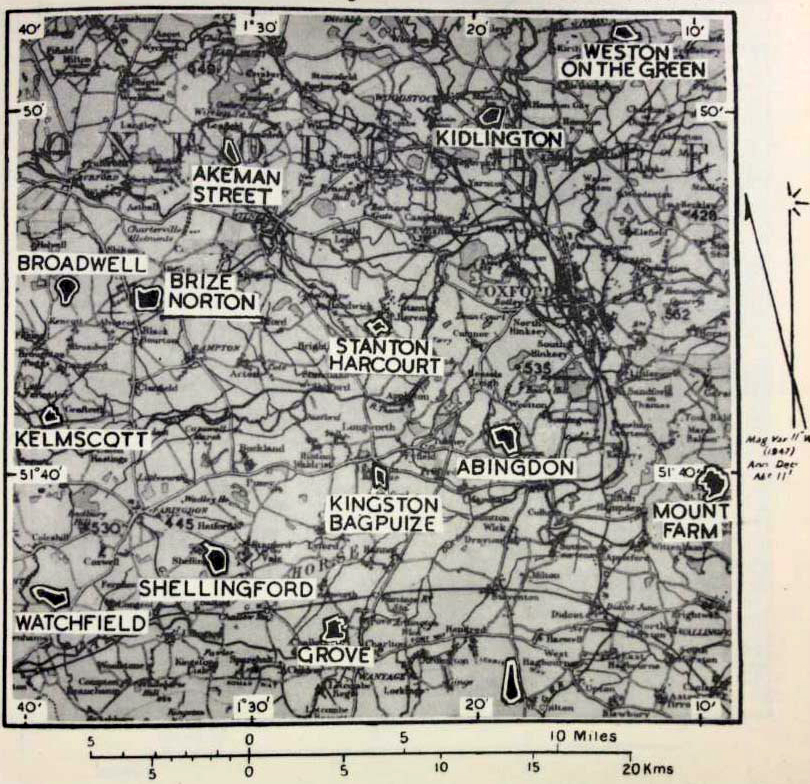
1501 BAT Flight moved from Abingdon to its Satellite Base at RAF Stanton Harcourt on 18th April 1943, Tom was appointed Commanding Officer of the latter Station.
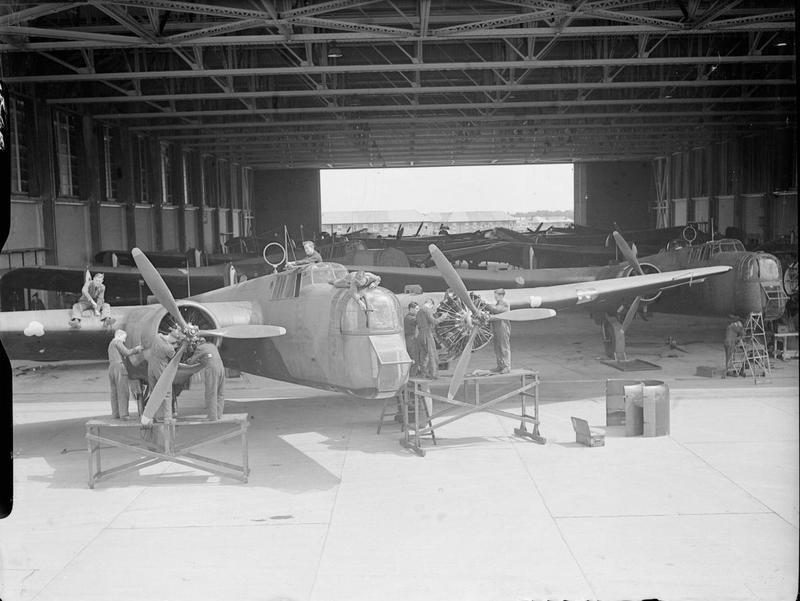
In December 1943, just before No.1501 BAT Flight Disbanded, Tom moved back to Abingdon, to join No.10-OTU as Chief Flying Instructor. The OTU was equipped with Whitleys, Ansons, Martinets & 1–Defiant. On 1st January 1944, Tom as Wing Commander, was Awarded the AFC & became Deputy Chief Instructor as well as Deputy Station Commander. Unfortunately, Tom did not elaborate on this Period!
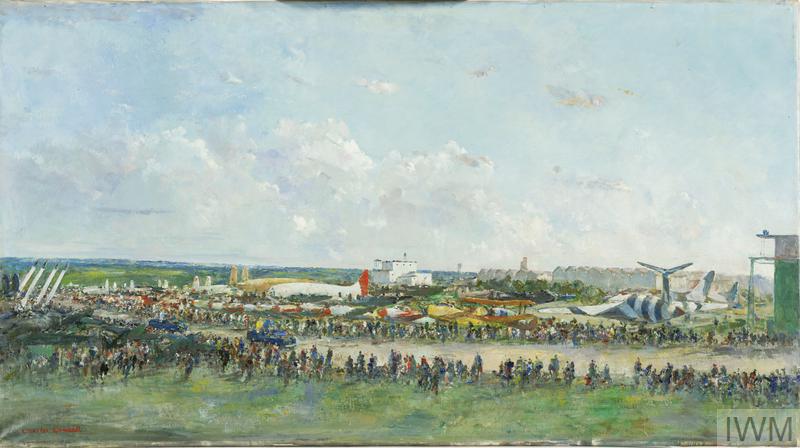
Visit of HM The Queen to RAF Abingdon on 14th June 1968 to Celebrate the 50th Anniversary of the Formation of the RAF – a view looking down on Crowds & brightly coloured Planes lining a Runway to Watch the Queen’s Arrival.
